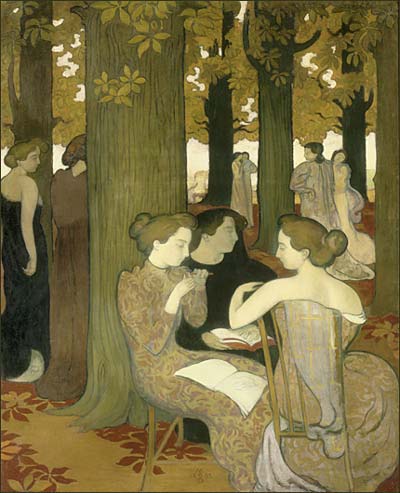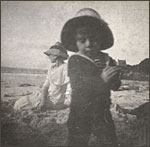
Maurice Denis, Les Muses, 1893 Oil on canvas H 171 x 137,5 Paris, musée d'Orsay Photo RMN / Hervé Lewandowski Copyright : ADAGP, Paris 2006
|
|
MUSÉE D'ORSAY
Entrance by the parvis 1, rue de la Légion d'Honneur
INFORMATION:
Tel.+33 01 40 49 48 00 / 49 78
Site: www.musee-orsay.fr
OPENING HOURS:
Every day, from 9:30 AM to 6 PM
Thursday until 9:45 PM
Closed on Monday
ADMISSION FEES:
Museum+Exhibition: Full rate: 9€
Concessions and sunday: 7€
Free admissions: under 18, and holders Carte blanche du musée d'Orsay, MuséO, La Carte jeune du musée d'Orsay
CURATORSHIP:
general curatorship: Serge Lemoine, président du musée d'Orsay
Guy Cogeval, directeur du Musée des beaux-arts de Montréal
Scientific curator: Jean-Paul Bouillon, professeur à l'université de Clermont-Ferrand et membre de l'Institut universitaire de France
Curators : Sylvie Patry, conservateur au musée d'Orsay, Isabelle Gaëtan, chargée d'études documentaires au musée d'Orsay, Nathalie Bondil, conservateur en chef et conservateur de l'art européen 1800-1945 au Musée des beaux-arts de Montréal
With the participation of Claire Denis
Photography : Françoise Heilbrun,
conservateur en chef au musée d'Orsay, assisted by Saskia Ooms, Nathalie Bondil
Drawingss : Marie-Pierre Salé,
conservateur au musée d'Orsay
PRESS CONTACT:
Amélie Hardivillier 01 40 49 48 56
Nacer Berry 01 40 49 47 42
E-mail presse@musee-orsay.fr

|
The Musée d’Orsay is putting on a major one-man show of the work of Maurice Denis, the first since the retrospective organized in 1970 at the Orangerie, and more than 10 years after that held in 1994 in Lyon, Cologne, Liverpool and Amsterdam. The purpose of this exhibition is to restore Denis to his rightful place of eminence, and to make a serious reassessment of how his work is viewed, by following the strands linking his earliest work with later developments, the small Nabi paintings with the large decorative pieces.. Alongside masterpieces, works often unseen before, or never exposed in France for more than a hundred years, appear aspects of his activity which are not as well known, like his work with landsxcape or the reconstitution of three of his most important decorative cycles
Walls, walls for decoration
The essentially chronological layout of the exhibition brings together about a hundred paintings made between 1889 and 1943. The first rooms retrace the beginnings of the Nabi movement, dominated by a rejection of realism and literary symbolism, where mystical and religious inclinations are embodied in the figure of Marthe Meurier, his fiancée, then wife, and his real muse. From the beginning of the 1890s, the Nabis were calling for “walls, walls for decoration”. Denis painted ceilings and panels, as in Avril (April) or Le Printemps (Forest in Spring) and L’Automne (Forest in Autumn). Like his Nabi friends, Denis produced more and more small paintings, each more daring in its application of the new aesthetic: flat surfaces of bright colour, a radical simplification of shapes, absence of perspective, Japanism and Synthetism. One room brings together about fifteen of these “Nabi icons” - some never exhibited before - painted by Denis in the 1890s. They show a rare freshness and freedom of execution.
An art increasingly monumental and reasoned
His symbolist compositions and decorative works benefited from this research, which he applied to an art which was becoming increasingly monumental and reasoned. His trip to Rome in 1898 with André Gide confirmed the move towards a classical revival, encouraged by the art of Raphael and Cezanne. Other equally important features both in Denis’ work and in early twentieth century art are the strict rules for composition, a restricted use of colour, the importance of drawing: noticeable in key works like L’Hommage à Cézanne (Tribute to Cézanne), in the large decorative panels, like Virginal Printemps a major painting never exhibited in a French gallery since 1945, but also seen in the family scenes, inspired by the happiness he shared with Marthe. By this time Denis was a well-known, revered and highly sought-after artist. His work was sold by Vollard, Druet and Bernheim and was much favoured by Ivan Morosov and his rival Sergei Shchukin, both eminent Russian collectors of Matisse and Picasso.
The turning towards classicism
The turning towards classicism becomes clear in the dazzling paintings of beaches where the atmosphere is close to that in his photographs taken at the same time. There is an exhibition room dedicated to these. It opens with the first work in the series painted in 1898, Baigneuses, Perros, (Women bathers, Perros). Denis’ beaches are also meant as a critical reply to Matisse. Denis tries to define a community art, which maintains balance, sensuality and order, between the constraints of the subject, the feeling for nature and decorative imagination. At the end of this chronological sequence, there is a display of landscapes painted between 1898 and 1943. They manage to show how a taste for simplicity and synthesis transform the reproduction of nature. On display for the first time is one of his last paintings, a Vue du Reposoir painted in pure Nabi spirit a few weeks before his death.
The last rooms show three decorative cycles. L’Amour et la vie d’une femme, La Légende de Saint Hubert (The legend of Saint Hubert): The Story of Psyche. Presented in part in 1908 and in 1909 in Paris, before been installed in Moscow, the complete work has never since been seen in France.
Photographies and drawings
Two exhibitions of photographies and drawings complete the main one. The museum présents for the first time, the photographies Maurice Denis took of his family and friends between 1896 and 1913. Through close-ups, the artist obtained silhouettes or blurred faces.. These pictures show his taste for symbolism, form simplification and lines harmony, and at the same time he did borrow from them motives traceable in his paintings. The museum also exhibits a corpus of drawings acquired in 2003, illustrating Sagesse by Paul Verlaine and the Fiorettiof Saint François d’Assise. ; The drawings of the young artist – then nineteen years old – for Sagesse are particularly important for the history of Nabi books. Praised on its publication in 1913 as a bibliophilic achievement, the illustrated edition of the Fioretti was of particular value for Denis, combining his love for italian art and landscape and his spiritual affection for the saint.
Illustration: Maurice Denis, Dominique with straw hat, standing on the beach, young woman sitting in the background, Perros-Guirec, août 1911. Gélatino-argentique print, 15,5 x 16,5 cm Album Druet 8.10 Musée d'Orsay, Claire Denis gift, 2006 Copyright ADAGP, Paris 2006
PÜBLICATION
Exhibition catalogue : Maurice Denis, 24,5 x 28 cm, 304 p., 230 colour ill., bound with dust jacket. Réunion des musées nationaux , 44 €
La photographie au musée d'Orsay : Maurice Denis, 96p., 62 colour ill., French, English and Italian, copublication 5 Continents/musée d'Orsay, distribution Le Seuil, 10 €
This exhibition has been coproduced by the Musée d'Orsay, the Réunion des musées nationaux, Montreal Museum for Fine Arts and the museo di Arte Moderna e Contemporanea di Trento Rovereto
Media partners : RATP, FIP, Paris Première, CRT
To see more illustrations, click on VERSION FRANCAISE at the top of this page
|









